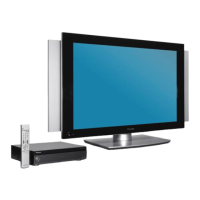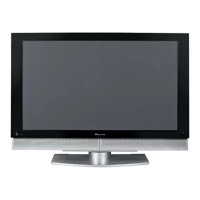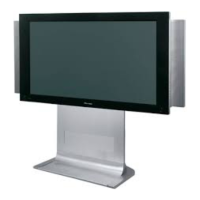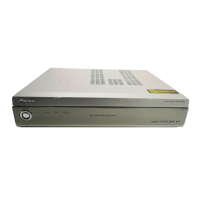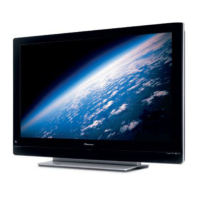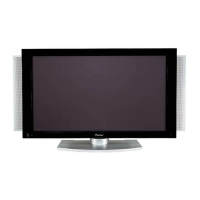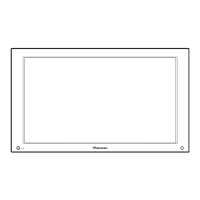
Do you have a question about the Pioneer PDP-435HDG and is the answer not in the manual?
| Screen Size | 43 inches |
|---|---|
| Display Technology | Plasma |
| Resolution | 1024 x 768 pixels |
| Aspect Ratio | 16:9 |
| Brightness | 1100 cd/m² |
| Contrast Ratio | 3000:1 |
| Viewing Angle | 160° (Horizontal/Vertical) |
| Inputs | HDMI, Component, S-Video, Composite |
Precautions to avoid after-image and permanent effects on the screen by managing static images.
Proper installation methods and ventilation requirements for safety and optimal performance.
Explains after-image lagging due to electrical load or screen burning.
Comprehensive safety guidelines covering product handling, electrical safety, and preventing damage.
Precautions for safe installation, ventilation, servicing, and power cord protection.
Warnings about product weight, handling, glass, heat sources, and sunlight exposure.
Specific safety advice for mounting the display using optional accessories.
Information on screen protection features, infrared rays, and radio interference.
Guidelines for cleaning, avoiding labels, and managing condensation.
List of accessories included with the Plasma Display.
List of accessories included with the Media Receiver.
Identifies front, right, and rear parts of the Plasma Display.
Labels and describes system and speaker terminals on the Plasma Display.
Identifies front controls and input/output terminals of the Media Receiver.
Labels and describes all rear input/output terminals of the Media Receiver.
Details the function of each button on the remote control.
Specifies the effective distance and angle for remote control operation.
Guidance on selecting a location and operating environment for the Plasma Display.
Refers to manuals for installing optional PIONEER stands and speakers.
Instructions for installing the Media Receiver with ventilation clearance.
Steps for installing the Media Receiver vertically using its stand.
How to connect the system cables between the Plasma Display and Media Receiver.
Instructions for bundling and securing cables using speed clamps and bead bands.
How to use the remote control and replace its batteries safely.
Guides for connecting the antenna and power cords for system setup.
Step-by-step instructions for turning the Plasma Display and Media Receiver on and off.
Explains indicator lights and how to change TV channels.
How to adjust the volume and mute the sound using the remote control.
How to select different sound modes (Stereo, Bilingual, Monaural) for broadcasts.
How to use split-screen modes and freeze images.
Lists available settings for Picture, Sound, Power Control, and Options in AV mode.
Lists available settings for Picture, Sound, Power Control, and Options in PC mode.
Explains menu operation keys and the process for auto channel installation.
Guides for automatically searching or manually tuning TV channels.
Details for setting program entry, search frequency, system, and color system.
How to name channels and set up the Child Lock feature with a password.
How to reorder channels and select menu/Teletext languages.
Explains the five viewing options (Standard, Dynamic, Movie, Game, User) for picture quality.
How to adjust Contrast, Brightness, Color, Tint, and Sharpness for better picture quality.
Adjustments for film-based content smoothness and white balance.
How to reduce mosquito noise in video images for a clearer picture.
How to use Digital Noise Reduction (DNR) and Color Transient Improvement (CTI).
Adjusting dynamic range and fine-tuning individual color hues for picture quality.
How to adjust Treble, Bass, Balance, and FOCUS for preferred sound.
Enabling SRS/TruBass for surround sound and using Energy Save for power reduction.
How the system automatically enters standby mode based on signal or operation status.
How the system manages power when connected to a PC and no signal is received.
Explains what Teletext is and its capabilities for information access.
How to turn Teletext on/off and switch between full screen and split screen.
Methods for navigating Teletext pages using color buttons and number keys.
How to view and manage multiple subpages within a Teletext broadcast.
How to connect a DVD player via INPUT 3 and display its video.
How to connect a VCR via INPUT 2 and display its video.
How to connect a digital tuner via INPUT 1 and view broadcast signals.
How to connect gaming consoles or camcorders via INPUT 4.
How to connect a PC and view its display, including compatibility information.
How to connect audio devices like AV receivers for enhanced sound output.
How to connect HDMI devices and activate the HDMI input terminal.
Setting digital signal types for optimal video and audio input via HDMI.
How to connect control cords for synchronized operation with other PIONEER equipment.
Manually adjusting horizontal and vertical image positions for AV sources.
Using Auto Setup to optimize PC image display positions and clock synchronization.
Manually adjusting PC image positions and clock when Auto Setup is insufficient.
Selecting the correct color system (PAL, NTSC, etc.) for clear AV image display.
Choosing screen sizes (4:3, Cinema, Zoom, Wide) for different video signals in AV mode.
Selecting screen sizes for various PC signal resolutions and types.
How Wide Screen Signalling (WSS) automatically adjusts screen format.
Setting the 4:3 aspect ratio and adjusting side mask brightness.
Setting the timer to automatically turn off the system.
How to enter, change, and reset the password for Child Lock features.
Detailed steps for modifying or resetting the system password.
Solutions for common problems like no power, no image, no sound, or picture distortion.
Explains error codes and pinouts for PC input connectors.
Recommended channel allocation selections for various countries and regions.
Technical specifications for the Plasma Display and Media Receiver models.
Lists registered trademarks, logos, and copyright details for the product.


